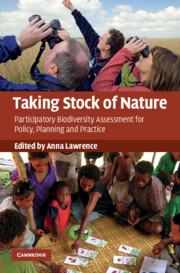Book contents
- Frontmatter
- Contents
- List of contributors
- Acknowledgements
- 1 Introduction: learning from experiences of participatory biodiversity assessment
- 2 Monitoring and assessment of biodiversity under the Convention on Biological Diversity and other international agreements
- 3 The Millennium Ecosystem Assessment: a multi-scale assessment for global stakeholders
- 4 Conservation of biological diversity in El Salvador shade coffee: the importance of taxonomic capacity for participatory assessments
- 5 Taking stock of nature in species-rich but economically poor areas: an emerging discipline of locally based monitoring
- 6 Researching local perspectives on biodiversity in tropical landscapes: lessons from ten case studies
- 7 Participatory resources monitoring in SW China: lessons after five years
- 8 Forest inventory in Nepal – technical power or social empowerment?
- 9 Perceptions of landscape change in British Columbia's Northwest: implications for biodiversity and participatory management
- 10 How thousands planned for a billion: lessons from India on decentralized, participatory planning
- 11 Inside monitoring: a comparison of bird monitoring groups in Slovenia and the United Kingdom
- 12 The personal and political of volunteers' data: towards a national biodiversity database for the UK
- 13 Improving forest management through participatory monitoring: a comparative case study of four community-based forestry organizations in the Western United States
- Index
- References
4 - Conservation of biological diversity in El Salvador shade coffee: the importance of taxonomic capacity for participatory assessments
Published online by Cambridge University Press: 06 December 2010
- Frontmatter
- Contents
- List of contributors
- Acknowledgements
- 1 Introduction: learning from experiences of participatory biodiversity assessment
- 2 Monitoring and assessment of biodiversity under the Convention on Biological Diversity and other international agreements
- 3 The Millennium Ecosystem Assessment: a multi-scale assessment for global stakeholders
- 4 Conservation of biological diversity in El Salvador shade coffee: the importance of taxonomic capacity for participatory assessments
- 5 Taking stock of nature in species-rich but economically poor areas: an emerging discipline of locally based monitoring
- 6 Researching local perspectives on biodiversity in tropical landscapes: lessons from ten case studies
- 7 Participatory resources monitoring in SW China: lessons after five years
- 8 Forest inventory in Nepal – technical power or social empowerment?
- 9 Perceptions of landscape change in British Columbia's Northwest: implications for biodiversity and participatory management
- 10 How thousands planned for a billion: lessons from India on decentralized, participatory planning
- 11 Inside monitoring: a comparison of bird monitoring groups in Slovenia and the United Kingdom
- 12 The personal and political of volunteers' data: towards a national biodiversity database for the UK
- 13 Improving forest management through participatory monitoring: a comparative case study of four community-based forestry organizations in the Western United States
- Index
- References
Summary
This chapter provides an overview of a project that took place in El Salvador between 1999 and 2002, entitled ‘Empowering local people to manage the biodiversity of El Salvador’. The project set out to support the participation of a broad range of stakeholders in the assessment of the biological diversity associated with shade coffee farms. Led by taxonomists at the Natural History Museum (NHM) and funded by the Darwin Initiative (both UK stakeholders), it sought to demonstrate that it was feasible and practical to monitor biological diversity using direct species level measurements – without on the one hand having to compromise the quality of the data generated, or on the other hand excluding stakeholders from the process. The situation of El Salvador in general and shade coffee farms in particular presented a real demand for the data and skills that such a project could generate, both to enable shade coffee to be incorporated into the biodiversity planning process, and to aid the development of national taxonomic capacity. The chapter shows how collaborations between taxonomists and the wider users of biological diversity data can result in the generation of significant taxonomic capacity. Capacity that can be used to monitor biodiversity as part of certification schemes to leverage premiums for the crop, national biodiversity action plans or local conservation initiatives.
Background
El Salvador is the most densely populated country in Latin America, with a population of 6.9 million occupying 21 000 km2 (The World Bank Group, 2007).
- Type
- Chapter
- Information
- Taking Stock of NatureParticipatory Biodiversity Assessment for Policy, Planning and Practice, pp. 69 - 87Publisher: Cambridge University PressPrint publication year: 2010
References
- 1
- Cited by



